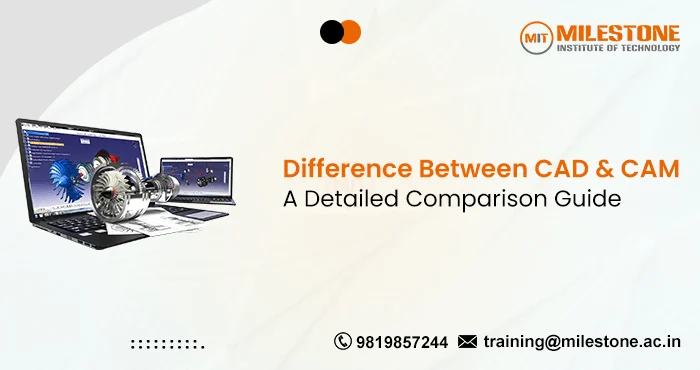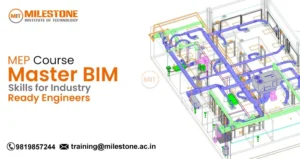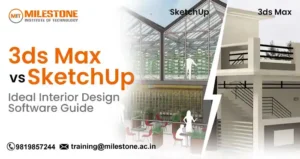In the world of manufacturing and design, CAD (Computer-Aided Design) and CAM (Computer-Aided Manufacturing) play pivotal roles. Both technologies streamline and enhance the design and manufacturing processes, but they serve distinct functions. Understanding the
difference between CAD and CAM is crucial for professionals in these fields. In this blog, we will explore what CAD and CAM are, their key features and applications, and how they work together. We will also highlight the benefits of using these technologies and provide guidance on where to learn CAD and CAM software.
What is CAD?
Computer-Aided Design (CAD) is a technology used to create detailed 2D and 3D models of physical objects and structures. CAD software enables designers and engineers to visualize and modify their designs with precision, facilitating the development of complex products and systems.
Key Features of CAD
- Precision and Accuracy: CAD software allows for high levels of precision and accuracy in design, which is crucial for engineering and architectural projects.
- 3D Modeling: CAD tools provide the ability to create and manipulate three-dimensional models, offering a realistic view of the final product.
- Customization: CAD systems support various customization options, enabling designers to tailor their models to specific requirements.
- Simulation and Analysis: CAD software often includes tools for simulating how designs will perform under various conditions, helping to identify potential issues before manufacturing.
- Documentation: CAD provides tools for generating detailed drawings and documentation, essential for production and assembly.
Applications of CAD
- Architecture: CAD is use to design and visualize buildings and structures, allowing architects to create detail plans and blueprints.
- Engineering: In engineering, CAD assists in designing mechanical parts, systems, and assemblies, helping engineers to test and refine their concepts.
- Industrial Design: Designers utilize CAD to create consumer products, machinery, and tools that fulfill both aesthetic and functional standards.
- Urban Planning: CAD helps urban planners design and simulate city layouts, infrastructure, and transportation systems.
What is CAM?
Computer-Aided Manufacturing (CAM) refers to the use of software and computer-controlled machinery to automate and manage the manufacturing process. CAM systems convert CAD designs into machine-readable instructions, enabling the automated production of parts and products.
Key Features of CAM
- Automation: CAM systems automate the manufacturing process, reducing the need for manual intervention and improving efficiency.
- Precision: CAM software ensures that the manufacturing process is precise and consistent, producing parts with high accuracy.
- Integration: CAM systems can integrate with CAD software to streamline the workflow from design to production.
- Toolpath Generation: CAM generates toolpaths that guide the machines in cutting, shaping, and assembling parts according to the design specifications.
- Monitoring and Control: CAM software provides tools for monitoring and controlling the manufacturing process, ensuring quality and reducing errors.
Applications of CAM
- Machining: In CNC machining, operators use CAM (Computer Aided Manufacturing) to achieve highly precise production of metal and plastic components.
- Injection Molding: In injection molding, CAM software helps in designing and controlling molds for producing plastic parts.
- Woodworking: People use CAM systems in woodworking to automate cutting, shaping, and assembling wooden components.
- Additive Manufacturing: CAM supports 3D printing processes by generating instructions for layer-by-layer material deposition.
Key Difference Between CAD and CAM (CAD vs CAM)
| Feature |
CAD |
CAM |
| Primary Function |
Design and visualization of products |
Manufacturing and production of parts |
| Focus |
Creating detailed 2D and 3D models |
Automating and controlling manufacturing processes |
| Output |
Design files and documentation |
Machine instructions and toolpaths |
| Integration |
Focuses on design creation and modification |
Focuses on translating designs into physical parts |
| Tools |
Design software, modeling tools |
3D printers, CNC machines, and further production tools |
| Usage |
Used by designers and engineers |
Used by machinists and production technicians |
How CAD and CAM Work Together
To expedite the process of developing new products, CAD and CAM are commonly used together. Parts and assemblies may be precisely designed and modeled using CAD software. Once a design is finalized, CAM software takes these designs and generates the necessary instructions for manufacturing. This integration ensures that we accurately translate designs into physical products, reducing errors and improving efficiency. For instance, CAM software can directly import a CAD design of a mechanical part and generate the necessary toolpaths for CNC machining.
Benefits of Using CAD and CAM
There are several advantages to combining CAD and CAM technologies:
- Enhanced Accuracy: CAD and CAM systems reduce human error by providing precise measurements and automated processes.
- Increased Efficiency: Automation and digital design streamline workflows, speeding up the design and manufacturing processes.
- Cost Savings: By identifying design flaws early and optimizing manufacturing processes, both can reduce material waste and production costs.
- Improved Collaboration: Team members and stakeholders can easily share and modify CAD files, facilitating collaboration.
- Flexibility and Adaptability: Both allow for easy modifications to designs and manufacturing processes, enabling quick adaptations to changes or new requirements.
Where to Learn CAD and CAM Software Course?
For those interested in mastering CAD and CAM software, numerous educational institutions and online platforms offer specialized courses. One notable option is the Milestone Institute of Technology, which provides comprehensive training programs on software such as AutoCAD,
SolidWorks, Siemens NX, and many more. These courses are designed to equip learners with the skills and knowledge needed to excel in design and manufacturing, offering hands-on experience with industry-standard tools and techniques. By enrolling in these programs, students can gain a deep understanding of most demanding software by building skills and techniques effectively for boosting their careers.
Frequently Asked Questions
What is the major difference between CAD vs CAM?
The main difference between both is their focus. CAD (Computer-Aided Design) is use for creating detail designs and models of products, while CAM (Computer-Aided Manufacturing) is use to automate and control the manufacturing process based on those designs.
Can CAD and CAM software be used together?
Yes, CAD and CAM software are often use together to streamline the design and manufacturing process. CAM software converts CAD designs into machine-readable instructions, ensuring accurate and efficient production of parts.
What are some popular CAD and CAM software programs?
Most popular software for CAM are
AutoCAD, SolidWorks, and CATIA. Common CAM software programs include Mastercam, Siemens NX, and Fusion 360. Each of these programs offers a range of tools and features for design and manufacturing tasks.




